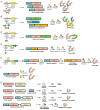Advancements in the Application of Ribosomally Synthesized and Post-Translationally Modified Peptides (RiPPs)
- PMID: 38672495
- PMCID: PMC11048544
- DOI: 10.3390/biom14040479
Advancements in the Application of Ribosomally Synthesized and Post-Translationally Modified Peptides (RiPPs)
Abstract
Ribosomally synthesized and post-translationally modified peptides (RiPPs) represent a significant potential for novel therapeutic applications because of their bioactive properties, stability, and specificity. RiPPs are synthesized on ribosomes, followed by intricate post-translational modifications (PTMs), crucial for their diverse structures and functions. PTMs, such as cyclization, methylation, and proteolysis, play crucial roles in enhancing RiPP stability and bioactivity. Advances in synthetic biology and bioinformatics have significantly advanced the field, introducing new methods for RiPP production and engineering. These methods encompass strategies for heterologous expression, genetic refactoring, and exploiting the substrate tolerance of tailoring enzymes to create novel RiPP analogs with improved or entirely new functions. Furthermore, the introduction and implementation of cutting-edge screening methods, including mRNA display, surface display, and two-hybrid systems, have expedited the identification of RiPPs with significant pharmaceutical potential. This comprehensive review not only discusses the current advancements in RiPP research but also the promising opportunities that leveraging these bioactive peptides for therapeutic applications presents, illustrating the synergy between traditional biochemistry and contemporary synthetic biology and genetic engineering approaches.
Keywords: RiPPs; bioactive peptides; genetic engineering; heterologous expression; high-throughput screening; synthetic biology.
Conflict of interest statement
The authors declare no conflicts of interest.
Figures





Similar articles
-
Exploring Bioactive Fungal RiPPs: Advances, Challenges, and Future Prospects.Biochemistry. 2024 Nov 19;63(22):2948-2957. doi: 10.1021/acs.biochem.4c00532. Epub 2024 Nov 5. Biochemistry. 2024. PMID: 39499622 Review.
-
Exploring ribosomally synthesized and post-translationally modified peptides through SPECO-based genome mining.Methods Enzymol. 2025;717:67-87. doi: 10.1016/bs.mie.2025.04.005. Epub 2025 May 24. Methods Enzymol. 2025. PMID: 40651835
-
Genome mining of RiPPs driven by highly efficient pathway reconstruction methods.Methods Enzymol. 2025;717:175-197. doi: 10.1016/bs.mie.2025.01.059. Epub 2025 Feb 14. Methods Enzymol. 2025. PMID: 40651824
-
Merging RODEO with genomic enzymology workflows to guide RiPP discovery.Methods Enzymol. 2025;717:29-65. doi: 10.1016/bs.mie.2025.01.057. Epub 2025 Feb 16. Methods Enzymol. 2025. PMID: 40651828
-
Plant peptides - redefining an area of ribosomally synthesized and post-translationally modified peptides.Nat Prod Rep. 2024 Jul 17;41(7):1020-1059. doi: 10.1039/d3np00042g. Nat Prod Rep. 2024. PMID: 38411572 Free PMC article. Review.
Cited by
-
Anticancer Ribosomally Synthesized and Post-Translationally Modified Peptides from Plants: Structures, Therapeutic Potential, and Future Directions.Curr Issues Mol Biol. 2024 Dec 26;47(1):6. doi: 10.3390/cimb47010006. Curr Issues Mol Biol. 2024. PMID: 39852121 Free PMC article. Review.
-
Genome mining identifies a diversity of natural product biosynthetic capacity in human respiratory Corynebacterium strains.mSphere. 2025 Jun 25;10(6):e0025825. doi: 10.1128/msphere.00258-25. Epub 2025 May 21. mSphere. 2025. PMID: 40396729 Free PMC article.
-
Integrating Metabolomics and Genomics to Uncover Antimicrobial Compounds in Lactiplantibacillus plantarum UTNGt2, a Cacao-Originating Probiotic from Ecuador.Antibiotics (Basel). 2025 Jan 24;14(2):123. doi: 10.3390/antibiotics14020123. Antibiotics (Basel). 2025. PMID: 40001367 Free PMC article.
-
Characterization and Probiotic Potential of Levilactobacillus brevis DPL5: A Novel Strain Isolated from Human Breast Milk with Antimicrobial Properties Against Biofilm-Forming Staphylococcus aureus.Microorganisms. 2025 Jan 14;13(1):160. doi: 10.3390/microorganisms13010160. Microorganisms. 2025. PMID: 39858927 Free PMC article.
References
-
- Arnison P.G., Bibb M.J., Bierbaum G., Bowers A.A., Bugni T.S., Bulaj G., Camarero J.A., Campopiano D.J., Challis G.L., Clardy J., et al. Ribosomally Synthesized and Post-Translationally Modified Peptide Natural Products: Overview and Recommendations for a Universal Nomenclature. Nat. Prod. Rep. 2012;30:108–160. doi: 10.1039/C2NP20085F. - DOI - PMC - PubMed
Publication types
MeSH terms
Substances
Grants and funding
LinkOut - more resources
Full Text Sources
Molecular Biology Databases
Miscellaneous

